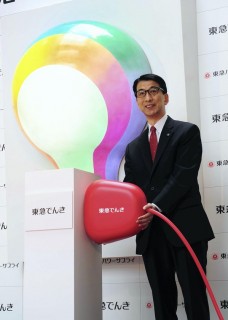Loading
Search
▼ Power Retail Market Opened for Competition
- Category:Other
TOKYO (Jiji Press) — Japan’s electricity retail business was fully liberalized on Friday, a landmark reform initiative to crack open an ¥8-trillion market that had been controlled by regional power monopolies for 65 years.
With the start of the new fiscal year, a total of 266 companies from a wide range of sectors, including gas and oil suppliers, telecommunications service providers and railway operators, will compete with each other and with major power utilities for a slice of the business to sell electricity to consumers as well as commercial and industrial users.
The market mechanism is expected to bring about lower prices and better services, but many households are still taking wait-and-see attitudes.
The regional monopoly system for electricity sales was introduced in 1951. Gradual market liberalization started in 2000, with sales to large-lot industrial uses such as big plants, but households and retail stores had remained off-limits to players other than 10 regional power monopolies.
A large-scale blackout after the March 2011 nuclear accident at Tokyo Electric Power Co.’s disaster-stricken Fukushima No.1 plant revealed that the regional monopoly system prevented the smooth and timely electricity supply between the major power companies when it counted.
Also in the face of consumer complaints over electricity rate hikes caused by nuclear reactor shutdowns, the government was prompted to go for the full liberalization of the electricity retail market by amending the Electricity Business Act.
New entrants to the market have started accepting applications from consumers and small business operators for electricity purchase contracts. But as of March 23, applications for switching power suppliers stood at 330,000 across Japan, accounting for only 0.5 percent of all household contracts totaling 62.6 million.
The new players are concentrated in the metropolitan areas around Tokyo and Osaka, western Japan, due to the large numbers of customers there. In addition, their price plans are designed primarily for high consumption families with monthly electricity bills of more than ¥10,000.
Few residents in smaller cities and single-member families see the benefits of shifting to new entrants.
According to a survey by price comparison website operator Kakaku.com Inc., half of electricity users who have not applied to change suppliers said they are taking a wait-and-see stance. Many of them do not plan to make decisions for six months to a year, suggesting that it will likely be long before the effects of the retail market liberalization can be evaluated in a meaningful way.
In April 2020, the electricity transmission and distribution divisions will be separated from the major power utilities, capping the power market liberalization in Japan.
Subsequently, the price structures of electricity suppliers could undergo significant revisions, possibly causing a massive shift of customers between power companies and hikes in electricity bills.
With the start of the new fiscal year, a total of 266 companies from a wide range of sectors, including gas and oil suppliers, telecommunications service providers and railway operators, will compete with each other and with major power utilities for a slice of the business to sell electricity to consumers as well as commercial and industrial users.
The market mechanism is expected to bring about lower prices and better services, but many households are still taking wait-and-see attitudes.
The regional monopoly system for electricity sales was introduced in 1951. Gradual market liberalization started in 2000, with sales to large-lot industrial uses such as big plants, but households and retail stores had remained off-limits to players other than 10 regional power monopolies.
A large-scale blackout after the March 2011 nuclear accident at Tokyo Electric Power Co.’s disaster-stricken Fukushima No.1 plant revealed that the regional monopoly system prevented the smooth and timely electricity supply between the major power companies when it counted.
Also in the face of consumer complaints over electricity rate hikes caused by nuclear reactor shutdowns, the government was prompted to go for the full liberalization of the electricity retail market by amending the Electricity Business Act.
New entrants to the market have started accepting applications from consumers and small business operators for electricity purchase contracts. But as of March 23, applications for switching power suppliers stood at 330,000 across Japan, accounting for only 0.5 percent of all household contracts totaling 62.6 million.
The new players are concentrated in the metropolitan areas around Tokyo and Osaka, western Japan, due to the large numbers of customers there. In addition, their price plans are designed primarily for high consumption families with monthly electricity bills of more than ¥10,000.
Few residents in smaller cities and single-member families see the benefits of shifting to new entrants.
According to a survey by price comparison website operator Kakaku.com Inc., half of electricity users who have not applied to change suppliers said they are taking a wait-and-see stance. Many of them do not plan to make decisions for six months to a year, suggesting that it will likely be long before the effects of the retail market liberalization can be evaluated in a meaningful way.
In April 2020, the electricity transmission and distribution divisions will be separated from the major power utilities, capping the power market liberalization in Japan.
Subsequently, the price structures of electricity suppliers could undergo significant revisions, possibly causing a massive shift of customers between power companies and hikes in electricity bills.
- April 2, 2016
- Comment (0)
- Trackback(0)


